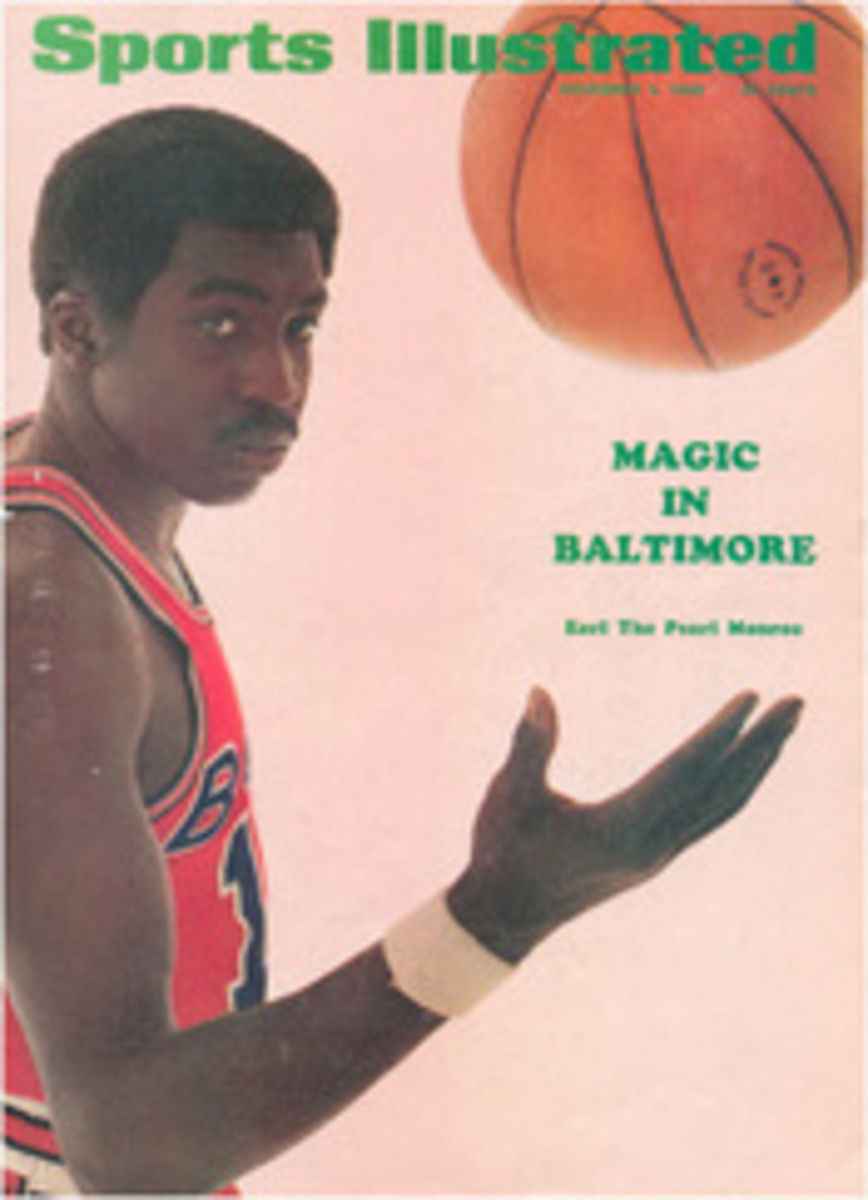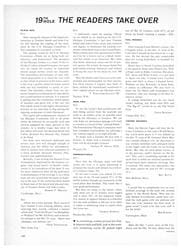
Teacher gets a taste of glory on the Coast
The line had been forming all day and was three miles long at 10 o'clock last Saturday night when the gate on the backside of the Riverside International Raceway opened. Hearty and hardy, the vanguard of the 83,000 people who the next day would see the Los Angeles Times Grand Prix—the fifth of this season's Canadian-American Challenge Cup races—began to move slowly into the track through the thick, stifling desert dust. They came in campers, mobile homes, chartered buses, little sports cars and occasionally a good old-fashioned Ford or Chevrolet.
They were college kids, high school kids in the process of losing their alcoholic virginity and adults who should have known better. About 30% of them were honest-to-goodness car buffs, the guys who can tweak their engines with all the skill of top-flight racing mechanics, and the rest were just plain $5-a-head fans out for a weekend's high-speed entertainment.
Greeting them all, it seemed, was The Enforcer. Six feet four inches and 270 pounds, he walked slowly up and down between the double line of vehicles, making quiet conversation in a gentle voice. Now and then he flicked his flashlight at the trunk of a car and told one of the security men to open it. And, sure enough, a sheepish kid trying to save $5 would pop out. "You can tell," The Enforcer said. "If there are fingerprints on the trunk you'd better take a look." Mostly, though, the crowd was playing no tricks. They responded to The Enforcer's greetings and called out, "Hi, Les."
Les Richter, six years and 30 pounds removed from the unsubtle violence of professional football—in which he became a legitimate California sports hero as a linebacker with the Los Angeles Rams—turned and waved his hand and smiled.
Richter is The Enforcer to his friends, but he is the president of Riverside to his stockholders, and the night before a big race he gets no sleep. For two hours last Sunday the raceway belonged to Bruce McLaren (SI, Oct. 28), who won the Grand Prix and the first prize of $21,610. But in the long hours of the night before the race and through the morning, the track was Richter's. Any infield the night before a race defies the clichés of sociology (or perhaps explains the need for the study of it), but Riverside has a distinct advantage: Southern California.
Richter moved slowly through the assembling crowd, first on a little motorcycle, then on foot. He was plugged into a walkie-talkie that kept him in constant contact with the security men around the sprawling 600-acre plant whose job was to maintain some semblance of order until the last spectators left Sunday night.
"I like to do this." Richter said. "I like to see what kind of people are here, where they're from and why they do a crazy thing like this."
Riverside is at once very easy and very difficult to explain: easy because it is located just 60 miles from Los Angeles and on the fringe of the Southern California population center of seven million. It is a good setting for selling just about anything, but the creature comforts are not exactly in evidence. The temperature approaches 100° during the day, when the smog permits, and at night the hot desert winds give way to a sudden chill, and it takes a good deal of ingenuity to make up for the old swimming pool and barbecue pit back at the split level.
Ingenious, though, the Riverside crowd was. Through the long night and well into Sunday morning, radios blared, portable television sets played and the inside of one magnificent truck looked like Hugh Hefner's living room. It was a huge thing, pinewood-paneled, with pictures of Playboy bunnies on the walls; a hi-fi stereo set blared country-and-western over most of Turn 5—the "jungle," as Richter calls the area—and out back the occupants were doing a real live buck-and-wing.
"I don't really think people would come to races if things were comfortable and antiseptic," Richter said. "This kind of thing brings out the gypsy in everybody. It's strange."
Richter grew up in Fresno, Calif. and was initiated to racing at the dirt tracks in Northern California—as a spectator—long before he went to the University of California, made All-America and started on the road to football fame. When he retired from the Rams after the 1962 season, he was invited to become the president of Riverside, and in his fifth season of running the most versatile race course in the U.S.—it is the only one that successfully supports Grand National stock cars and U.S. Auto Club championship cars as well as sports cars—has put the track into the black financially and has seen it become the most charismatic racing attraction going. It draws the Hollywood crowd, notably James Garner, Dick Smothers, Paul Newman and Dan Blocker, whose party of 20 rented a Greyhound bus for the weekend; the international crowd, with Stirling Moss out front; and the split-level Torrance crowd as well, and they all have a good time, although it does take that security force of 50 men to keep the gypsy in everybody within reasonable limits.
What the gypsies—Hollywood, bare-tummied and otherwise—saw on the track was more of the old McLaren Can-Am magic. Team McLaren Owner-Driver Bruce and hired gun Denis Hulme had rented the 3.2-mile circuit on Thursday, one day before official practice began, to work some bugs out of their cars. Hulme never made it. His polar flight from London had mechanical difficulty. No matter. McLaren himself tooled around the course just 11 times, took two-tenths of a second off the track record and retired for the rest of the day to the swimming pool at Riverside's Mission Inn.
On Friday, McLaren did things officially, getting around in 1:38.51 at an average speed of 119.683 mph. Nobody else was even close. Gusty winds and a lot of oil on the track kept times slow during the final qualifying session on Saturday, but Hulme slammed his way into the first row alongside his teammate. That made the fourth time in the five Can-Am races to date that the Kiwis had been together on the first row.
Behind Team McLaren came Mark Donohue, half a second slower, and Jim Hall, two lengths behind Donohue. And poor Mario Andretti. Crew Chief George Bignotti had just received a new Ford aluminum 427-cu.-in. engine and a new Lola chassis and, in effect, tried to build a race car in a day. It didn't work, and Andretti, who deserves better, did not even make the starting grid. Both Peter Revson and Dan Gurney, the other two name drivers using Ford engines, fell out of contention early. Revson, who qualified fifth, had blown an engine late Saturday, and the replacement lasted just one lap of the race itself. Gurney, No. 6 on the grid, was blowing smoke on the first lap—oil was leaking onto the exhaust pipes. He pitted several times and completed just seven of the 62 laps.
The early laps of the race, like the qualifying sessions, were a mirror of the entire Can-Am series. McLaren and Hulme challenged each other only on the first lap, with McLaren winning a deep dive into the No. 9 turn at the end of the mile-long back straight, and in a very short time the field was spread out. After just six laps McLaren led Hulme by approximately three seconds; there was another five-second gap to the cars driven by Hall and Donohue and a startling 26-second margin between them and fifth-place John Surtees. And by the 25th lap those four Chevrolet-powered racers had lapped the rest of the field. It was definitely a day for beer drinking and girl watching, and both girls and beer, fortunately, were in plentiful supply.
Hall was forced to pit on the 38th lap with braking problems, which moved Donohue into third place. Thirteen laps later Hulme spun coming out of Turn 5. Another car had broken loose in front of him and Hulme had a sudden choice of hitting the other car or taking a detour. He chose the detour, had to pit to repair his bodywork, and McLaren breezed home an easy 36-second winner over Donohue.
Hulme did manage to finish fifth, but his little shunt may have cost him the Can-Am driving championship. Going into the race, the reigning Grand Prix champion had a seven-point lead over Donohue. Coming out of it, Hulme has 26 points, with McLaren and Donohue tied for second at 23 each. And that means the driving title, worth $40,000, won't be decided until the series' last race in Las Vegas on November 10.
McLaren quite naturally was pleased with his victory. It was his first of the series this year, and until this race he had been content to let Hulme bring Team McLaren the driving championship, mostly because Hulme was the man with the best chance to win it. But after the race he said, "I thought I'd be a driver today instead of an instructor."
PHOTO
McLAREN SPEEDS AROUND RIVERSIDE COURSE IN RACER OF HIS OWN DESIGN, WHICH HAS DOMINATED CAN-AM SPORTS CAR SERIES
PHOTO
STIRLING MOSS (LEFT) SUNS IN PITS

